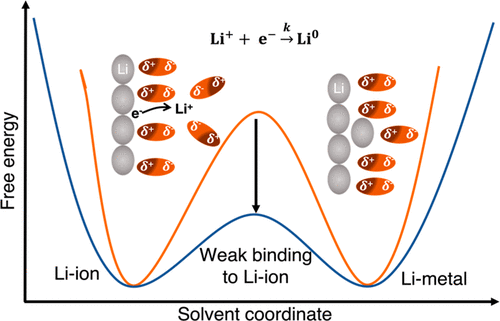当前位置:
X-MOL 学术
›
ACS Energy Lett.
›
论文详情
Our official English website, www.x-mol.net, welcomes your feedback! (Note: you will need to create a separate account there.)
Transient Voltammetry with Ultramicroelectrodes Reveals the Electron Transfer Kinetics of Lithium Metal Anodes
ACS Energy Letters ( IF 22.0 ) Pub Date : 2020-02-07 , DOI: 10.1021/acsenergylett.0c00031 David T. Boyle 1 , Xian Kong 2 , Allen Pei 3 , Paul E. Rudnicki 2 , Feifei Shi 3 , William Huang 3 , Zhenan Bao 2 , Jian Qin 2 , Yi Cui 3, 4
ACS Energy Letters ( IF 22.0 ) Pub Date : 2020-02-07 , DOI: 10.1021/acsenergylett.0c00031 David T. Boyle 1 , Xian Kong 2 , Allen Pei 3 , Paul E. Rudnicki 2 , Feifei Shi 3 , William Huang 3 , Zhenan Bao 2 , Jian Qin 2 , Yi Cui 3, 4
Affiliation

|
Fully understanding the mechanism of lithium metal deposition is critical for the development of rechargeable lithium battery anodes. The heterogeneous electron transfer kinetics are an important aspect of lithium electrodeposition, but they have been difficult to measure and understand. Here, we use transient voltammetry with ultramicroelectrodes to explicitly investigate the electron transfer kinetics of lithium electrodeposition. The results deviate from the Butler–Volmer model of electrode kinetics; instead, a Marcus model accurately describes the electron transfer. Measuring the kinetics in a series of electrolytes shows the mechanism of lithium deposition under electron transfer control is consistent with the general framework of Marcus theory. Comparison of the transient voltammetry results to electrochemical impedance spectra provides a strategy for understanding how the interplay of the electron transfer and mass transport resistances affect the morphology of lithium.
中文翻译:

超微电极的瞬时伏安法揭示了锂金属阳极的电子转移动力学。
充分了解锂金属沉积的机理对于可充电锂电池负极的开发至关重要。异质电子转移动力学是锂电沉积的重要方面,但是很难测量和理解。在这里,我们使用瞬态伏安法与超微电极来明确研究锂电沉积的电子转移动力学。结果偏离电极动力学的巴特勒-沃尔默模型;相反,马库斯(Marcus)模型可以准确地描述电子转移。测量一系列电解质的动力学表明,在电子转移控制下锂沉积的机理与马库斯理论的总体框架是一致的。
更新日期:2020-02-07
中文翻译:

超微电极的瞬时伏安法揭示了锂金属阳极的电子转移动力学。
充分了解锂金属沉积的机理对于可充电锂电池负极的开发至关重要。异质电子转移动力学是锂电沉积的重要方面,但是很难测量和理解。在这里,我们使用瞬态伏安法与超微电极来明确研究锂电沉积的电子转移动力学。结果偏离电极动力学的巴特勒-沃尔默模型;相反,马库斯(Marcus)模型可以准确地描述电子转移。测量一系列电解质的动力学表明,在电子转移控制下锂沉积的机理与马库斯理论的总体框架是一致的。



























 京公网安备 11010802027423号
京公网安备 11010802027423号